The brackish water is the hallmark of the Baltic Sea. The inflow of both saltwater and freshwater sets it apart from other seas, making it both unique and vulnerable. But what role do these water inflows play in the Baltic Sea’s marine environment? And how are they affected by climate change? BalticWaters has dived into the issue to explore the significance of these inflows.
The fact that the Baltic Sea is sometimes compared to a lake has several explanations. One reason lies in its unique history – at various times, our inland sea has actually been a lake. Changes in sea levels and land uplift have continuously shaped the character of the Baltic Sea, leading to alternating periods of freshwater dominance and increased salinity.
Today, the Baltic Sea is shaped by water inflows from both the North Sea and runoff from surrounding rivers – an interaction between saltwater and freshwater, where oxygenation and water movements influence the marine environment and ecosystem. However, both inflows and runoff are affected by climate change and other human impacts, which have consequences for our inland sea.
To understand how these processes work and what they mean for the future of the Baltic Sea, we need to dive deeper into its complex world of water. You’re coming with, right?
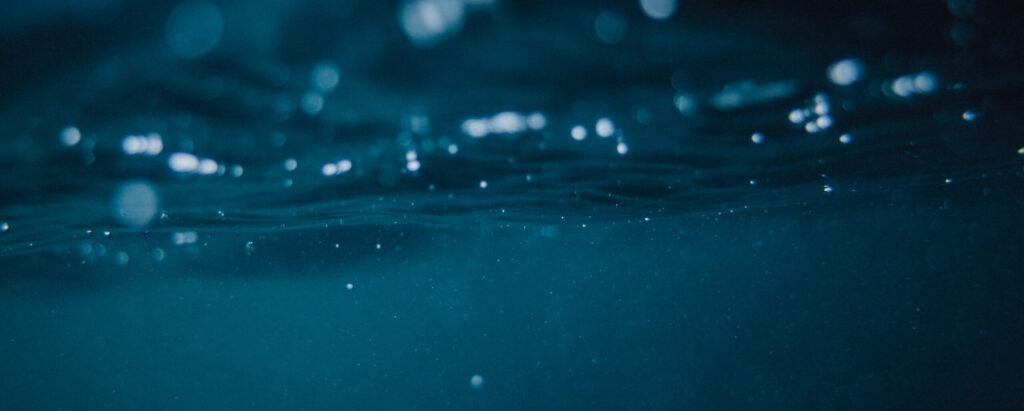
Salt and oxygen-rich water is brought in from the North Sea
Between Sweden and Denmark lie the Danish straits, Öresund and Bälten. The narrow passages of the straits prevent water from flowing freely in and out of the Baltic Sea. Yet it is here, at this narrow threshold to the North Sea, that the largest exchange of water in the inland sea takes place. We meet Lars Arneborg, research leader at SMHI’s oceanographic research unit, to find out how the inflows work.
– It is mainly the winds that drive the inflow of salt water to the Baltic Sea through the impact they have on the water level. Minor inflows happen all the time, but major inflows are rare and occur about once every ten years, he says.
A specific combination of weather and sea conditions is required for a major water inflow to occur. The water level in the Baltic Sea needs to be low, which can be caused by easterly winds that lower the water level in the North Sea and Skagerrak and eventually the Baltic Sea. If strong southerly to westerly winds then occur, the water level in the North Sea and Skagerrak and Kattegat will rise again. The difference in level between Skagerrak and Kattegat and the southern Baltic Sea creates a gradient that drives the salt water through the straits and into the inland sea.
But weather and water levels are not the only factors at play.

– For a large inflow to reach the deep basins of the Baltic Sea, the water must also be sufficiently salty. Only then will it be heavy enough to displace the deep water already in the Baltic Sea, Lars explains.
Distinguishing between different types of inflows is important in this context, as it is only the larger inflows that can significantly change the salinity and oxygen conditions of the inland sea. But to understand why this is important, we first need to look deeper into how water moves in the Baltic Sea and how salt and fresh water are distributed in different parts of the water column.
Baltic Sea water flows create varying environmental conditions
The Baltic Sea is a sea marked by contrasts, at least when it comes to its environmental conditions. Salinity and oxygen levels vary significantly, both vertically in the water column and geographically, creating unique conditions for species to live in different parts of the sea. The explanation lies in the design of the inland sea and – yes, you guessed it – its water flows.
The water flows create a clear geographical difference in the Baltic Sea. Closer to the North Sea, the water is significantly saltier, while salinity gradually decreases in the eastern and northern parts, where a larger inflow of freshwater dilutes the seawater. But the differences are not only noticeable between different areas – salinity also changes with depth.
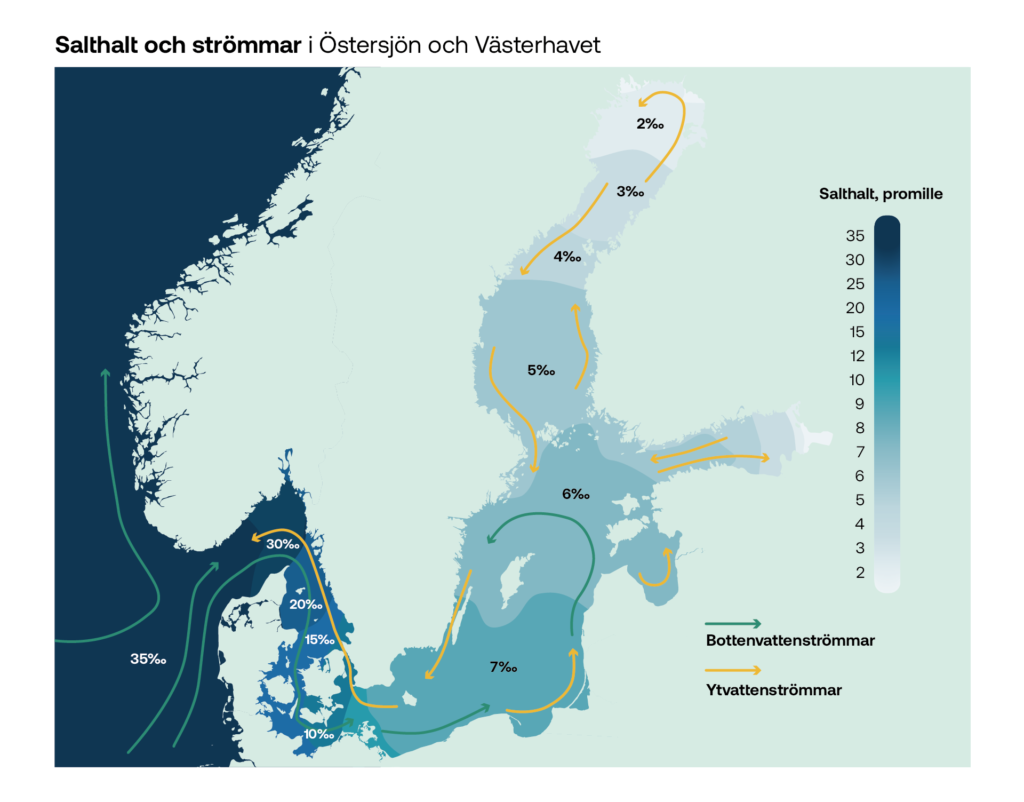
Map of the salinity of the Baltic Sea’s surface waters and the currents that control the inland water circulation. Bottom currents carry the salty water from the North Sea northwards into the Baltic Sea. At the same time, there is an opposite movement at the surface, where the fresher surface water moves anti-clockwise and finds its way out through the Danish straits. Illustration: Sofie Handberg
Translation:
Salthalt och vattenströmmar i Östersjön och Västerhavet = Salinity and water currents in the Baltic and Western Seas
Salthalt, promille = Salinity, per mille
Bottenvattenströmmar = Bottom water currents
Ytvattenströmmar = Surface water currents
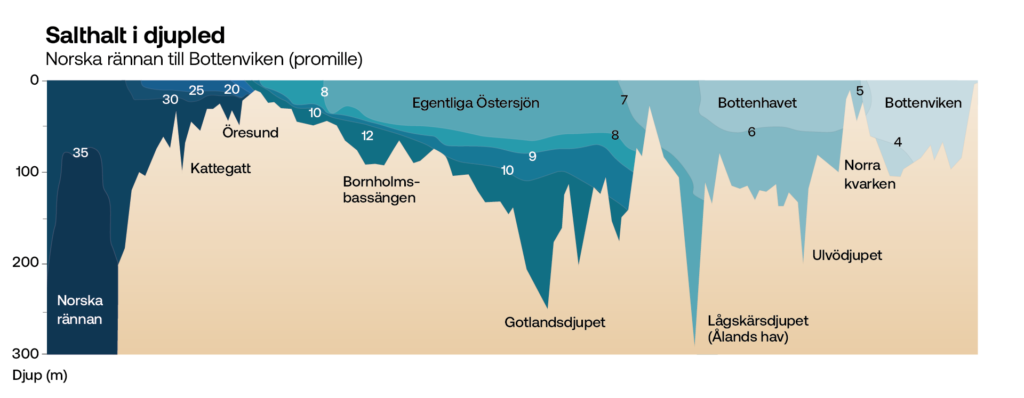
Salinity in the Baltic Sea varies in depth – with higher salinity at the bottom and lower closer to the surface. Salinity gradually decreases towards the north of the Baltic Sea.Illustration: Sofie Handberg
Translation:
Salthalt i djupled = Salinity in depth
Norska rännan till Bottenviken (promille) = Norwegian Channel to Gulf of Bothnia (per mille)
Djup (m) = Depth (m)
When the salt- and oxygen-rich waters of the North Sea meet the lighter freshwater, a distinct stratification is formed, where the heavier seawater sinks to the bottom and the freshwater stays closer to the surface. This halocline, or salt front, acts as an invisible barrier that prevents the mixing of the water layers.
– Stratification is an inherent issue for the Baltic Sea, and there have always been periods of oxygen depletion due to the stagnant deep waters. At the same time, animals and plants have long adapted to the salt and oxygen conditions that prevail in different parts of the inland sea, explains Lars.
But the oxygen conditions we see in the Baltic Sea today are not natural. For decades, nutrient inputs from land, especially from agriculture, have fuelled severe eutrophication of the Baltic Sea. This has led to widespread oxygen depletion with a major impact on marine life.
How are eutrophication and oxygen depletion linked?
Nutrients such as nitrogen and phosphorus are essential for life in the Baltic Sea, but in excessive amounts they lead to eutrophication and large algal blooms. When the algae die, they sink to the bottom, where decomposition consumes oxygen and creates oxygen deficiency. Despite our success in reducing nutrient discharges, it is estimated that half of the Baltic Sea’s seabeds are completely anoxic or suffer from oxygen deficiency. This is partly because it takes a long time for the large amount of nutrients already in the sea to be either transported away or permanently bound in the bottom sediments.
Could inflows from the North Sea increase oxygen depletion in the Baltic Sea?
At first glance, it might seem obvious that large saltwater inflows from the North Sea help reduce oxygen depletion in the deep waters of the Baltic Sea. But what actually happens to the oxygen once the water has made its way through the straits? We take that question to Bo Gustafsson, a researcher in oceanography and eutrophication at Stockholm University.
– There is a general belief that inflows of water from the North Sea are good for the Baltic Sea, but the effect can actually be the opposite, he states.
Certainly, the large inflows bring oxygen-rich water, but the positive effect is not as significant as one might think.
– Without the inflows, oxygen depletion would be worse, but they don’t solve the real problem – eutrophication. The Baltic Sea has a huge oxygen debt, which means that the oxygen introduced is quickly consumed, explains Bo.

But can the large saltwater inflows actually worsen the situation? Yes, says Bo, because the addition of salt strengthens the stratification in the water, making it harder for new oxygen to reach the oxygen-depleted seafloor.
– When stratification is stronger, the area where the water can mix and become oxygenated becomes smaller. Additionally, the stratification moves further up the water column, meaning the portion of deep water that can actually be replenished shrinks, he says.
How climate change is expected to affect Baltic Sea water flows
How the future of the Baltic Sea will unfold partly depends on how we manage the issue of eutrophication. But there are also other external forces that will impact the water circulation of the inland sea and, in turn, the entire marine environment and its ecosystem. One such force is climate change.
We turn back to Lars Arneborg, a researcher at SMHI, who is working on developing climate scenarios for the Baltic Sea’s water inflows until 2100. Among the uncertainties in the forecasts, Lars points to one thing that is certain – sea levels will rise.
– Melting glaciers and ice sheets, along with the expansion of water at higher temperatures, will contribute to rising sea levels in the North Sea. This will make it easier for saltwater to flow into the Baltic Sea, says Lars.
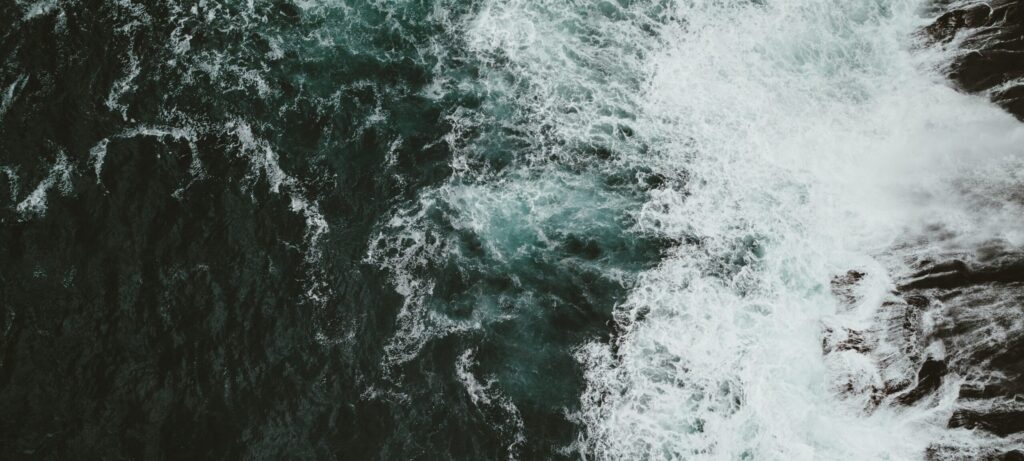
But it is still uncertain how an increased inflow of saltwater will affect the environmental conditions in the Baltic Sea. At the same time, precipitation is expected to increase, which could lead to a greater influx of freshwater into the inland sea.
– Increased precipitation leads to lower salinity and could counteract the effect of the expected saltwater inflows and even reduce the inflows themselves by creating a greater rise in water levels in the Baltic Sea than in the North Sea, explains Lars.
There are still significant uncertainties surrounding both of these processes, making it impossible to predict how the environmental conditions in the Baltic Sea will change due to climate change.
– For example, how much sea level will rise depends on how much ice mass melts from Antarctica – a process that, in turn, is influenced by several uncertain factors, not least how successfully we manage to limit global warming, says Lars.
How does a climate model work?
A climate model is a mathematical description of the atmosphere, oceans, land and ice, used to simulate how the climate evolves in response to changes in the composition of the atmosphere, such as increases in greenhouse gases. The models are based on assumptions about future emissions and other influencing factors. Unlike weather forecasts, which focus on short-term changes, climate models also take into account slow processes in the land and ocean, as they affect the climate in the longer term.
Source: SMHI
Did you know that…
… running a climate model is extremely demanding in terms of computing power? Depending on the resolution and number of processors, a single simulation can take several months to complete. The global climate model EC-Earth, used by SMHI, can calculate 150 years in just two weeks.
Source: SMHI
The ecosystem is affected when inflows change
With uncertain scenarios for future changes in the Baltic Sea’s water circulation and environmental conditions, it is, of course, difficult to predict how the ecosystem will be affected. However, Lars presents some possible effects based on how the inflows may change.
– In a scenario with higher sea levels and more saltwater from the North Sea, stratification in the Baltic Sea would be strengthened and shifted higher in the water column, which would lead to worsened oxygen conditions near the bottom, says Lars.
An expansion of oxygen-deprived areas would negatively affect certain species. At the same time, the increased salinity could benefit some species. In a reversed scenario, where the water becomes fresher due to increased precipitation, freshwater species would be favored, while species that require higher salinity would be disadvantaged. This scenario could also lead to worsened oxygen conditions in the water, according to Lars.
– The inflow of freshwater from land brings nutrients that could increase eutrophication and thereby oxygen consumption in the water.
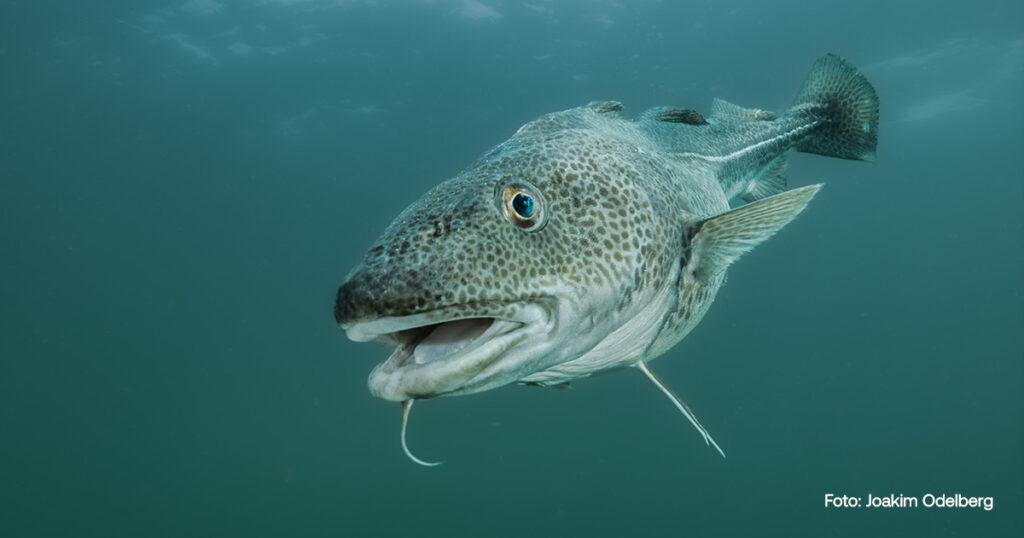
The Balitc cod depend on specific environmental conditions
Changing environmental conditions in the Baltic Sea affect the living conditions of species that are adapted to the unique environment of the Baltic Sea. One such species is the Baltic cod, which, after decades of overfishing and mismanagement, is facing an acute situation. One reason why cod stocks have not been able to recover is that cod depend on specific levels of salinity and oxygen to reproduce – levels that are currently only met in one location in the Baltic Sea. Cod recovery may be further hampered as temperature, salinity and oxygen levels in the Baltic Sea change as a result of climate change.
What do we really know about the tolerance of cod to different environmental conditions? Read more here.
We need to strengthen ecosystem’s resilience to uncertain impacts
So what can we do to prepare the ecosystem for the impacts of changing water inflows? The first answer is perhaps obvious, but also the most difficult.
– To mitigate the effects of climate change, we must first and foremost reduce greenhouse gas emissions to keep global temperatures down, says Lars.
Despite the uncertainty regarding how the inflow dynamics will change, we already have enough knowledge to take action. Even though climate models and our understanding of how ecosystems are affected are continuously developing, there are measures we can take today to strengthen the ecosystem’s resilience and prepare for future changes.
By restoring ecological structures and functions, the resilience of ecosystems is improved. This is important work because ongoing climate change increases the risk of permanent changes to the ecosystem.
– When it comes to the Baltic Sea’s marine environment, it is crucial to continue reducing eutrophication. Other important measures could include accelerating work on marine protected areas or improving fisheries policies for more sustainable management, says Lars.
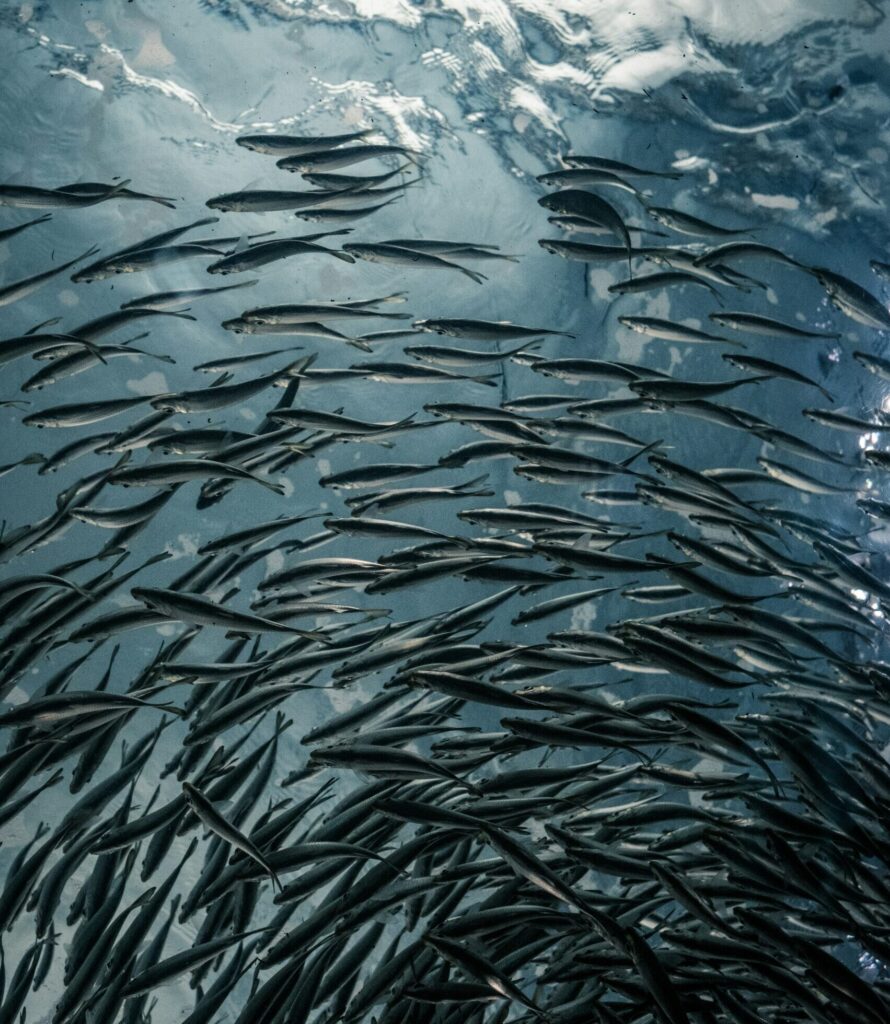
And even though the vision of a healthy and vibrant inland sea, both now and in the future, is reason enough to act, there are also strong socio-economic reasons to raise our level of ambition.
– In addition to affecting the ecosystem, for example, rising sea levels will also have significant physical and socio-economic consequences for coastal areas. By acting now, we can reduce large future costs, concludes Lars.

BalticWaters comment:
The inflows of saltwater and the influx of freshwater to the Baltic Sea have shaped its unique marine environment and ecosystem. It is important to be prepared for how a changed inflow dynamic could impact the sea’s environmental conditions and living conditions. However, the inflows cannot be pinpointed as an explanation for marine environmental issues. The spread of oxygen-depleted areas in the Baltic Sea is primarily a result of nutrient leakage from land, which is the issue that needs to be addressed.
The most important thing to do in a situation where the effects of climate change and changing water inflows are uncertain is to act proactively and cautiously. By taking further measures to reduce eutrophication and managing our fish stocks in a more sustainable way, we can strengthen the ecosystem’s resilience and prepare the Baltic Sea for the changes that are already underway – even if we don’t yet know exactly what they will entail.

